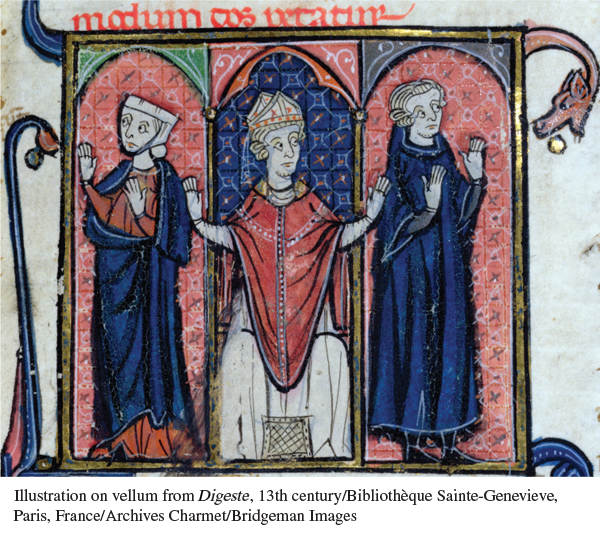A History of Western Society: Printed Page 267
A History of Western Society, Value Edition: Printed Page 255
A History of Western Society, Concise Edition: Printed Page 268
The Popes and Church Law
Pope Urban II laid the foundations for the papal monarchy by reorganizing the papal curia (the central government of the Roman Church) and recognizing the college of cardinals as a definite consultative body. The papal curia had its greatest impact as a court of law. As the highest ecclesiastical tribunal, it formulated church law, termed canon law. The church developed a system of courts separate from those of secular rulers that handled disputes over church property and ecclesiastical elections and especially questions of marriage and annulment. Most of the popes in the twelfth and thirteenth centuries were canon lawyers who expanded the authority of church courts.
The most famous of the lawyer-
Innocent called the Fourth Lateran Council in 1215, which affirmed the idea that ordained priests had the power to transform bread and wine during church ceremonies into the body and blood of Christ (a change termed transubstantiation). According to papal doctrine, priests now had the power to mediate for everyone with God, setting the spiritual hierarchy of the church above the secular hierarchies of kings and other rulers. The council affirmed that Christians should confess their sins to a priest at least once a year, and that marriage was a sacrament, and thus indissoluble. It also ordered Jews and Muslims to wear special clothing that set them apart from Christians.

By the early thirteenth century papal efforts at reform begun more than a century earlier had attained phenomenal success, and the popes ruled a powerful, centralized institution. At the end of the century, however, the papacy again came into a violent dispute with secular rulers. Pope Boniface VIII (pontificate 1294–1303), arguing from precedent, insisted that King Edward I of England and Philip IV of France obtain his consent for taxes they had imposed on the clergy. Edward immediately denied the clergy the protection of the law, and Philip halted the shipment of all ecclesiastical revenue to Rome. Boniface had to back down.
The battle for power between the papacy and the French monarchy became a bitter war of propaganda, with Philip at one point calling the pope a heretic. Finally, in 1302, in a formal written statement known as a papal bull, Boniface insisted that all Christians — including kings — were subject to the pope. (See “Evaluating the Evidence 9.2: Pope Boniface VIII, Unam Sanctam.”) Philip maintained that he was completely sovereign in his kingdom and responsible to God alone. French mercenary troops assaulted and arrested the aged pope at Anagni in Italy. Although Boniface was soon freed, he died shortly afterward. The confrontation at Anagni foreshadowed further difficulties in the Christian Church in the fourteenth century.